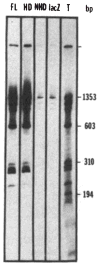The Drosophila developmental gene, engrailed, encodes a sequence-specific DNA binding activity
- PMID: 4079979
- PMCID: PMC2880619
- DOI: 10.1038/318630a0
The Drosophila developmental gene, engrailed, encodes a sequence-specific DNA binding activity
Abstract
Plasmid expression vectors carrying either the entire engrailed coding region or a subfragment including the homoeo box, produce protein fusions having sequence-specific DNA binding activity.
Figures






References
Publication types
MeSH terms
Substances
Grants and funding
LinkOut - more resources
Full Text Sources
Other Literature Sources
Molecular Biology Databases

